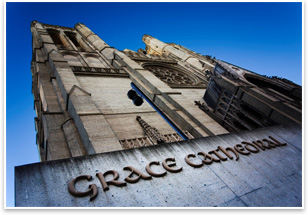San Francisco’s Grace Cathedral Goes Solar
With the help of generous donations and green incentives, this city icon comes around to alternative energy
by Zach Mortice
Associate Editor
 How do you . . . integrate solar PV panels into a historically sensitive, iconic piece of architecture? How do you . . . integrate solar PV panels into a historically sensitive, iconic piece of architecture?
Summary: A donation from Pacific Gas and Electric Company and rebate incentives from the GoSolarSF program have allowed San Francisco’s Grace Cathedral to invest in a solar power system. SolarCity, one of the nation’s largest solar panel installers, has designed the array and elected to hide the panels from view in order to preserve the church’s French Gothic architecture. Sally Bingham, of the nonprofit California Interfaith Power and Light, helped to broker the donation deal between Grace Cathedral and Pacific Gas and Electric.
As president and founder of California Interfaith Power and Light, Sally Bingham has been pushing for a progressive, faith-based response to global warming, starting with the church at which she performed liturgical services—Grace Cathedral in San Francisco. Ten years ago, she urged the church to install solar photovoltaic panels on the roof during a renovation project. Church leaders were concerned about the aesthetic impact such a retrofit would have on the richly detailed French Gothic cathedral, and were equally concerned of what their Nob Hill neighbors might think of the renovation. Solar power was considered an expensive and exotically unsightly technology that didn’t make fiscal sense for one of San Francisco’s most beloved houses of worship.
“Now the climate is very different, not to make a pun,” says Bingham.
Today, with the aid of progressively green civic policies and a donation from a major utility investor in solar power, solar panels on Grace Cathedral will soon be soaking up the sun.
Funding solar
One of the nation’s largest solar installers, SolarCity of Foster City, Calif., will complete the $80,000, 10 kW solar array. Construction has begun, and the church expects it to be finished this fall.
Bingham helped to broker this deal after approaching the Pacific Gas and Electric Company 18 months ago about making a donation for the project. The energy utility came through with a $65,000 gift. Her Regeneration Project and California Interfaith Power and Light nonprofits operate in 29 states and have more than 500 member congregations, of which Grace Cathedral was an early member.
Pacific Gas and Electric has provided $300 million in solar power rebates as part of California’s Self-Generation Incentive program and has also made a $7.5 commitment to increase solar power use in San Francisco. A major investor in solar power, this utility company pledged to buy 800 megawatts of solar power from two companies (OptiSolar and SunPower) that are building the two largest solar power plants in the world. GoSolarSF, a local solar power incentive program launched on July 1—just weeks before the Grace Cathedral solar power announcement—will provide additional funding. This program can pay half the cost or more of a solar array installed in the city, and the incentives are based on the size of the solar array. For nonprofit institutions such as the cathedral, GoSolarSF offers $1,500 per kilowatt. Grace Cathedral spokesperson Heidi Zuhl says the cathedral is the first organization of its kind to work with the program.
A solar start
The church’s solar panels will generate 5-10 percent of the building’s total power, which SolarCity chief operating officer and co-founder Peter Rive calls a “modest contribution” that they plan on adding to later.
“It’s a beginning, and they can always add more,” says Bingham.
The cathedral announced the solar panel project on July 16 at a public ceremony complete with a speech by San Francisco Mayor Gavin Newsom, but for all this publicity and attention, SolarCity elected to keep its PV panels largely hidden from view. They will be installed on a flat section of the building’s south roof, facing southward. This plan allows access to the sun’s most consistently shining rays, but it is also the result of aesthetic decisions as well. Rive says he didn’t feel that placing an obvious array of solar panels on visible sections of the church’s concrete deck roof would have been a sensitive treatment of Lewis Hobart’s original design. The current incarnation of Grace Cathedral was built from 1928-1964 as the third largest Episcopal church in the nation.
To compensate for the solar array’s low profile, SolarCity produces promotional materials that include informational kiosks and Web sites that teach visitors about this alternative energy source.
SolarCity created extensive 3D models to assess the visual impact of their solar retrofit and also took extra care not to disrupt the building’s electrical conduits and electrical ductwork, but beyond this Rive says they faced few specific technical challenges.
Rive says once the Grace Cathedral project is completed, the building will become a myth buster—proving that with the proper care and consideration, you can install PV panels in the most architecturally sensitive, historic, and iconic structures. “It’s an eyesore if you don’t think about aesthetics before you start building it,” he says. “You’ve got to make absolutely sure that the design of the PV system complements or integrates with the building itself.”
|


 How do you . . .
How do you . . . 